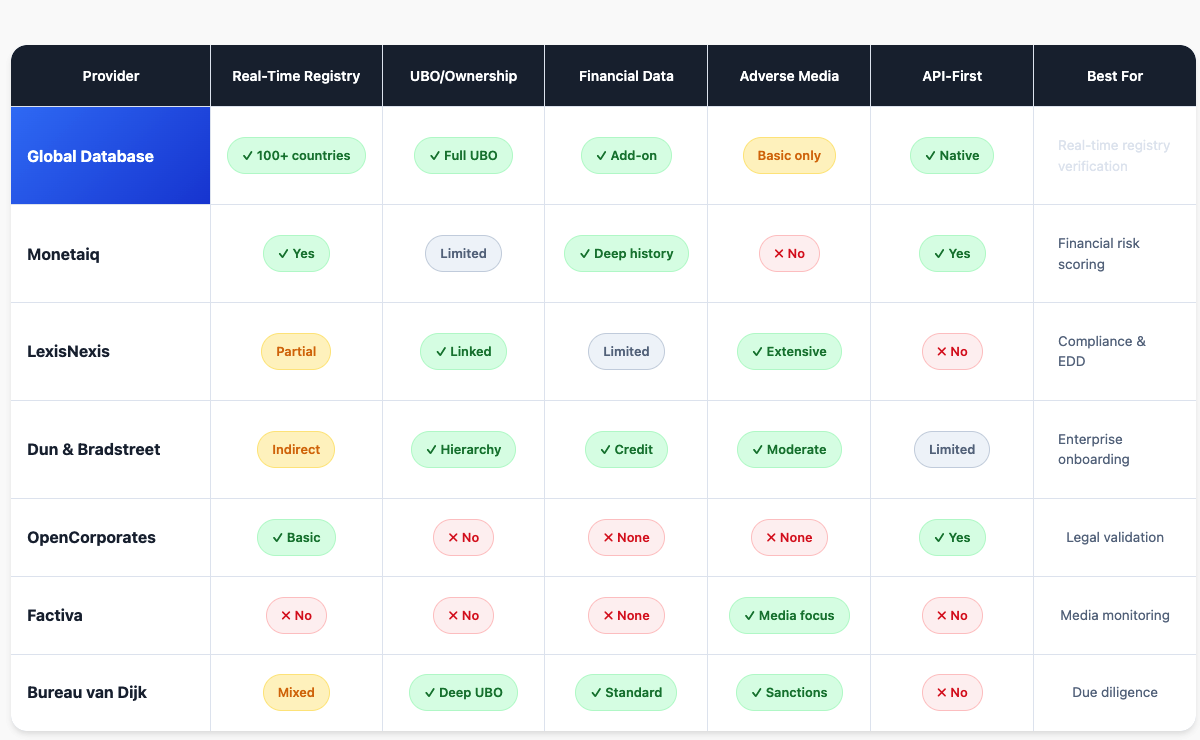
How Fintechs Are Automating Company Checks Across 150+ Countries — Without Scaling Headcount
1. Introduction
If you’re building a fintech product that touches company onboarding, payments, lending, or compliance, you’ve probably faced this dilemma:
How do we scale global KYB without scaling headcount?
Verifying companies across borders is messy. Every jurisdiction has its own rules, registries, languages, and data structures. Most teams start with manual checks — spreadsheets, local providers, and browser tabs galore. But as soon as you expand beyond a few core markets, this process breaks.
Meanwhile, regulators are tightening KYB standards. Customers expect instant approvals. And your product team can’t afford to wait three days for a human to confirm a company exists.
That’s why modern fintechs are automating company verification using registry-sourced data and APIs — shifting from fragmented, manual reviews to scalable, real-time flows.
This article breaks down how they’re doing it — without adding headcount, compromising compliance, or building everything in-house.
2. The Manual Burden of Global Company Checks
Verifying companies might seem simple — until you try doing it across 10, 20, or 150 countries.
Most fintech teams start small:
- Someone Googles the business name
- Checks the local company registry (if they can find it)
- Screens for red flags manually
- Copies key details into a CRM or compliance tool
But this doesn’t scale.
Here’s what makes global company checks painful:
- No standard format:Some registries return PDFs. Others show results in the local language. Some don’t allow public lookups at all.
- Jurisdictional complexity:Each country has its own legal forms, tax codes, and compliance fields. What’s required in Germany may be irrelevant in Brazil.
- Slow onboarding timelines:Manual KYB checks can delay user onboarding by days — especially if internal reviews or escalations are required.
- Staffing pressure:The more markets you serve, the more operations people you need to verify businesses — which eats into margin and slows product velocity.
- High error rates:Copy-paste errors, outdated data, and inconsistent interpretation create risk for compliance and customer experience.
As your fintech expands, the cost of doing this manually becomes unsustainable — and creates friction right where it hurts most: customer conversion and risk management.
3. What Needs to Be Verified (and Why It’s Hard at Scale)
Whether you’re launching in one market or 100, most regulators — and your internal risk team — expect you to answer the same core question:
Is this a real company, and can we trust them?
But verifying that isn’t as straightforward as it sounds. Each country presents unique documentation, terminology, and visibility into company structures. Here’s what fintechs are expected to check — and why it’s so challenging.
Core Checks You Need to Automate:
- Legal existence
- Does the company exist in the official registry?
- Is it currently active or has it been dissolved?
- What’s the official registration number?
- Basic identifiers
- Registered legal name and address
- Incorporation date and country of origin
- Legal entity type (LLC, GmbH, SA, etc.)
- Company status and activity
- Is the company dormant, newly formed, or trading?
- Has it filed recent financials?
- Ownership and control
- Who ultimately owns or controls the company?
- Are they individuals or other legal entities?
- Are there PEPs or sanctioned individuals involved?
- Identifiers and tax references
- VAT number, LEI, DUNS, or national ID (varies by jurisdiction)
Why It’s Hard at Scale:
- Different formats and languages: No two registries are the same. Some use Cyrillic, others don’t offer English interfaces at all.
- Partial disclosures: Some countries don’t disclose UBOs or shareholders publicly — others do but only in fragmented formats.
- Missing real-time updates: Relying on bulk feeds or static databases means you miss ownership changes, dissolutions, or reinstatements.
- No global standards: Terms like “Ltd” or “Sàrl” might mean entirely different things — even inside the EU.
Manually chasing this data across dozens of jurisdictions is risky, expensive, and slow. That’s why fintechs are turning to registry-sourced APIs to verify all this in milliseconds — not days.
4. The Role of Registry-Sourced Data in Fintech Infrastructure
Fintech companies need speed. Regulators need certainty. Customers expect both.
That’s why registry-sourced data — information pulled directly from official government registries — is becoming the backbone of modern KYB and onboarding infrastructure.
Why Registry Data Matters
- It’s verifiable:You can trace every record back to its official source — making it audit-proof and regulator-ready.
- It’s trusted:Unlike scraped or self-reported data, registry data is created and maintained by governments and regulatory bodies.
- It’s universal:Every legitimate company is required to register somewhere. You get a single point of truth across borders.
Use Cases in Fintech
Fintechs are embedding registry data into:
- Onboarding flowsPre-fill company info, validate legal status, and run ownership checks in real time.
- Risk enginesScore clients based on company age, financials, or shareholder history.
- Compliance opsAutomate UBO screening, flag sanctioned shareholders, and store registry snapshots for audits.
- Fraud preventionDetect shell companies, inactive businesses, or mismatches between declared and actual ownership.
Real-World Example
A cross-border payments platform recently integrated registry data to verify companies in over 90 countries. The result?
- Onboarding time dropped from 48 hours to under 15 minutes
- UBO flagging improved by 40%
- Operations team avoided hiring 3 additional KYB analysts
Without registry data, your fintech is relying on guesswork. With it, you’re building on facts.
5. Automating the Workflow with APIs
Manual KYB checks are time-consuming, error-prone, and don’t scale. The solution? Automate verification by plugging registry-sourced data directly into your onboarding, compliance, and risk systems using APIs.
Here’s how the most efficient fintechs are doing it.
Trigger Real-Time Checks at Key Moments
APIs allow you to verify and enrich company information automatically during:
- Signup and onboardingAuto-fill company name, number, address, legal form, and incorporation date.
- Ongoing monitoringGet alerts when a company changes directors, shareholders, or status.
- Risk reassessmentsPull updated financials or ownership info before approving loans or increasing limits.
Enrich Records Instantly
With a single API call, you can return:
- Registered legal name and address
- Business activity (industry codes)
- Key identifiers (VAT, LEI, registration numbers)
- Ownership and group structure
- Filing history and status (active, dissolved, etc.)
This eliminates copy-paste workflows, human lookups, and stale data across systems.
Best Practices for Fintech API Integrations
- Retry logic and error handling:Registries may throttle or timeout — build in smart fallbacks.
- Country-specific flows:Not all fields are available in every country. Build conditional logic for handling partial records.
- Audit trails:Store the registry response for each verification request, including timestamps and source registry IDs.
- Webhook architecture:Use webhooks to handle asynchronous verification results or update downstream systems in real time.
APIs are no longer just a developer tool — they’re a growth lever. The more automation you build, the faster you onboard, the fewer people you need to hire, and the stronger your risk posture becomes.
6. Example Architecture: From Input to Automation
Let’s walk through how modern fintechs build streamlined company verification pipelines using registry data APIs — from user input to automated decision.
Step 1: Input Collection
Trigger the flow with minimal data:
- Company name
- Website domain
- Registration number (if available)
- Country of incorporation
This can happen during:
- Account signup
- Payment onboarding
- Merchant KYB
- Beneficial owner declarations
Step 2: Match & Lookup via API
Call Zephira’s API using the provided data:
- Perform fuzzy or exact name matching
- Resolve the correct registry and country
- Return a normalized, structured profile:
- Legal name, ID, incorporation date
- Status (active, dissolved, pending)
- Full address, industry codes
- Tax IDs, LEI, DUNS
- Shareholders and UBOs (if available)
Step 3: Decisioning Engine
Send the returned data into your internal KYB or risk logic:
- Approve instantly if everything matches and no red flags
- Flag for manual review if:
- Company is inactive
- Shareholders are opaque or risky
- Key identifiers are missing
Some fintechs layer additional logic like:
- Age of company > 12 months
- Revenue or funding thresholds
- Sector-specific rules (e.g., no crypto, no shell companies)
Step 4: Update and Monitor
Push verified records into your CRM, database, or case management system. Set up:
- Automated refreshes (e.g., monthly updates on UBOs or legal status)
- Change alerts when new filings, director updates, or dissolutions occur
- Webhooks to update your platform or trigger follow-up actions
With this architecture, fintechs can process thousands of verifications per day — with no manual effort, no latency, and full traceability.
7. Results: Less Manual Review, Faster Time to Revenue
Fintechs that automate company checks using registry-sourced APIs aren’t just reducing friction — they’re unlocking faster growth, stronger compliance, and leaner operations.
Here’s what success looks like when you get this right:
Faster Onboarding
- Before: Manual KYB checks took 1–3 days.
- After: Automated verification reduced onboarding time to under 15 minutes.
One cross-border payments platform reduced onboarding abandonment by 35% simply by pre-filling and validating company details at signup.
Fewer Ops Hires
- Before: Each new market required additional KYB analysts.
- After: One API integration scaled onboarding across 90+ countries without increasing headcount.
Instead of hiring local experts, these teams let the data do the heavy lifting — with full audit trails and jurisdiction-specific logic handled automatically.
Stronger Compliance Outcomes
- Full traceability: Every record is sourced, timestamped, and compliant with local regulations.
- Real-time monitoring: Changes in company status or ownership trigger proactive flags.
- Audit-ready logs: Responses are stored in case of regulator review or dispute.
Faster Time to Revenue
Every hour shaved off onboarding means faster activation, faster payments, and faster monetization. And when sales teams know they can onboard any legitimate company, in any country, in minutes — they sell more confidently.
8. Choosing the Right Data Provider for Global Company Checks
Not all data providers are created equal. While many claim “global coverage,” few offer the depth, freshness, or legal traceability required for serious fintech operations.
Here’s what to look for when selecting a company data provider:
Must-Have Criteria
- Registry-sourced data
- Can they prove that their data comes directly from official registries?
- Or are they scraping, aggregating, or relying on outdated third parties?
- Real-time access
- Do they offer on-demand lookups via API with up-to-date information?
- Or do you need to wait hours or days for a batch file?
- Coverage quality
- Can they go beyond surface-level data (e.g. include UBOs, directors, and tax IDs)?
- How many countries offer full ownership structures and statuses?
- Standardization
- Do they normalize formats across jurisdictions (dates, legal forms, statuses, etc.)?
- Can you integrate the data without building a new parser per country?
- Flexibility & pricing
- Is their model API-first with granular pricing (pay per call, not per country)?
- Are you locked into bundles or long-term contracts?
Red Flags to Watch For
- “Global” coverage with limited depth in most countries
- Lack of proof for source or update frequency
- Rigid, outdated delivery formats (CSV, Excel via email)
- Limited technical documentation or sandbox
- No transparency on how they handle missing or partial data
Choosing the right partner is the difference between automating confidently and constantly second-guessing your KYB flow. Your infrastructure is only as strong as the data it runs on.
9. Key Takeaways
Automating company checks across 150+ countries is no longer a dream — it’s a necessity for scaling fintech products in a fast, compliant, and customer-friendly way.
Here’s what we’ve covered:
- Manual KYB checks don’t scale.They slow onboarding, introduce risk, and require growing headcount as you expand.
- Registry-sourced data is the foundation.It’s trusted, traceable, and structured — giving you verifiable insights into legal status, ownership, and more.
- APIs turn that data into automation.With the right provider, you can verify, enrich, and monitor companies at signup, not after the fact.
- The payoff is massive.Faster time to revenue, fewer ops hires, better compliance outcomes — and a smoother customer experience.
- Your data provider makes or breaks it.Choose one that gives you depth, speed, coverage, and flexibility — not just a static feed with a pretty UI.
If your team is scaling onboarding, compliance, or B2B risk intelligence, registry-sourced automation should be on your roadmap — not in the “maybe later” pile.
Want to see how Zephira can power global KYB via API? Let’s talk.
FAQ: Automating Company Checks with Registry Data
1. What is registry-sourced data?
It’s company information pulled directly from official government registries — including legal status, registration numbers, shareholders, UBOs, and more.
2. Why is registry data better than scraped or aggregated sources?
Registry data is legally verifiable, traceable, and typically updated in real time. Scraped data can be outdated, incomplete, or inaccurate.
3. How many countries can you verify companies in using APIs like Zephira?
Zephira supports over 150 countries, with standardized, real-time access to registration, ownership, and financial data.
4. Can this replace my manual KYB workflow entirely?
Yes — most fintechs use API-triggered verification and enrichment at signup, and only escalate edge cases for manual review.
5. What happens when registry data isn’t available in a specific country?
Zephira flags gaps clearly and offers partial records where possible, so you can apply fallback logic or manual checks as needed.
6. How long does integration take?
Most teams go live in days, not months. Zephira offers full API docs, SDKs, and a sandbox to test everything before deploying.

